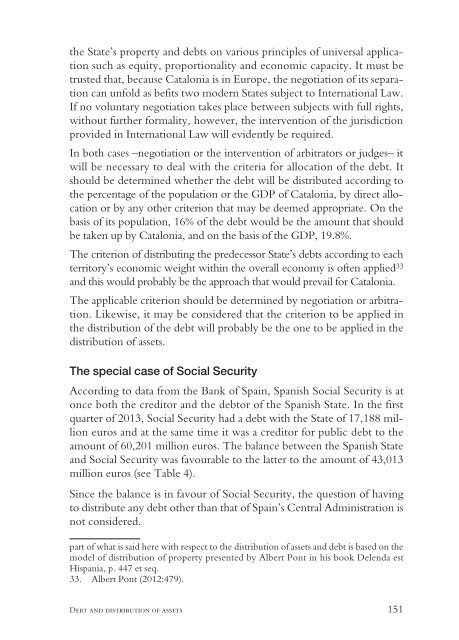The Economy of Catalonia
the_economy_of_catalonia._questions_and_answers_on_the_economic_impact_of_independence
the_economy_of_catalonia._questions_and_answers_on_the_economic_impact_of_independence
Create successful ePaper yourself
Turn your PDF publications into a flip-book with our unique Google optimized e-Paper software.
the State’s property and debts on various principles <strong>of</strong> universal application<br />
such as equity, proportionality and economic capacity. It must be<br />
trusted that, because <strong>Catalonia</strong> is in Europe, the negotiation <strong>of</strong> its separation<br />
can unfold as befits two modern States subject to International Law.<br />
If no voluntary negotiation takes place between subjects with full rights,<br />
without further formality, however, the intervention <strong>of</strong> the jurisdiction<br />
provided in International Law will evidently be required.<br />
In both cases –negotiation or the intervention <strong>of</strong> arbitrators or judges– it<br />
will be necessary to deal with the criteria for allocation <strong>of</strong> the debt. It<br />
should be determined whether the debt will be distributed according to<br />
the percentage <strong>of</strong> the population or the GDP <strong>of</strong> <strong>Catalonia</strong>, by direct allocation<br />
or by any other criterion that may be deemed appropriate. On the<br />
basis <strong>of</strong> its population, 16% <strong>of</strong> the debt would be the amount that should<br />
be taken up by <strong>Catalonia</strong>, and on the basis <strong>of</strong> the GDP, 19.8%.<br />
<strong>The</strong> criterion <strong>of</strong> distributing the predecessor State’s debts according to each<br />
territory’s economic weight within the overall economy is <strong>of</strong>ten applied 33<br />
and this would probably be the approach that would prevail for <strong>Catalonia</strong>.<br />
<strong>The</strong> applicable criterion should be determined by negotiation or arbitration.<br />
Likewise, it may be considered that the criterion to be applied in<br />
the distribution <strong>of</strong> the debt will probably be the one to be applied in the<br />
distribution <strong>of</strong> assets.<br />
<strong>The</strong> special case <strong>of</strong> Social Security<br />
According to data from the Bank <strong>of</strong> Spain, Spanish Social Security is at<br />
once both the creditor and the debtor <strong>of</strong> the Spanish State. In the first<br />
quarter <strong>of</strong> 2013, Social Security had a debt with the State <strong>of</strong> 17,188 million<br />
euros and at the same time it was a creditor for public debt to the<br />
amount <strong>of</strong> 60,201 million euros. <strong>The</strong> balance between the Spanish State<br />
and Social Security was favourable to the latter to the amount <strong>of</strong> 43,013<br />
million euros (see Table 4).<br />
Since the balance is in favour <strong>of</strong> Social Security, the question <strong>of</strong> having<br />
to distribute any debt other than that <strong>of</strong> Spain’s Central Administration is<br />
not considered.<br />
part <strong>of</strong> what is said here with respect to the distribution <strong>of</strong> assets and debt is based on the<br />
model <strong>of</strong> distribution <strong>of</strong> property presented by Albert Pont in his book Delenda est<br />
Hispania, p. 447 et seq.<br />
33. Albert Pont (2012:479).<br />
Debt and distribution <strong>of</strong> assets 151


